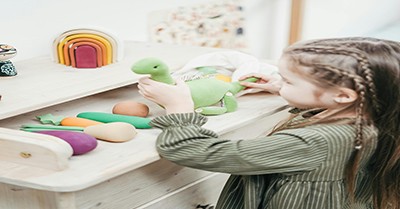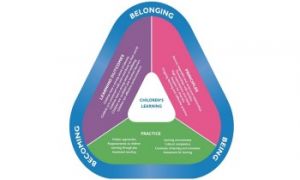Creating responsive play spaces means designing environments that adapt to children's interests, needs, and developmental stages. Here are some key strategies:
1. Flexible and Open-Ended Materials
- Provide loose parts like blocks, fabric, and natural objects for creative play.
- Use multipurpose furniture that can be rearranged for different activities.
2. Child-Led Exploration
- Design spaces that allow children to choose activities based on their curiosity.
- Include quiet areas for reflection and active zones for movement.
3. Sensory and Nature-Based Play
- Incorporate natural elements like sand, water, and plants.
- Use textures, sounds, and colors to stimulate sensory exploration.
4. Inclusive and Culturally Rich Spaces
- Display artwork and materials that reflect diverse cultures.
- Create spaces for storytelling and group discussions to encourage social learning.
5. Adaptable Learning Environments
- Allow for changes in layout based on children's evolving interests.
- Use movable walls, cushions, and outdoor areas to expand play possibilities.
Mix and Match Materials to Create Unique Spaces
Mixing and matching materials is a fantastic way to create unique and dynamic spaces that feel inviting and visually engaging. Here are some creative approaches:
1. Layering Textures for Depth
- Combine soft fabrics like velvet with rugged materials like reclaimed wood for contrast.
- Pair smooth ceramics with woven textiles to add warmth and variety.
2. Balancing Natural and Industrial Elements
- Use stone or clay accessories alongside metal accents for an earthy yet modern feel.
- Mix wood and glass to create a sleek yet organic aesthetic.
3. Playing with Light and Shadow
- Incorporate reflective surfaces like polished metal or glass to enhance brightness.
- Use matte finishes to create depth and reduce glare.
4. Creating Focal Points with Contrasts
- Pair dark and light materials to highlight key areas in a room.
- Use bold textures like rough brick against smooth plaster for visual interest.
5. Experimenting with Small Accents
- Try layering rugs with different textures for a cozy effect.
- Mix cushions and throws in various fabrics to add personality to a space.
Inviting Play Spaces Encourage Interaction
Inviting play spaces are essential for fostering interaction, creativity, and engagement among children. Here are some key elements that encourage meaningful play:
1. Open-Ended Materials
- Provide loose parts like blocks, fabric, and natural objects for imaginative play.
- Use multi-purpose furniture that can be rearranged for different activities.
2. Flexible Learning Areas
- Create quiet zones for reflection and active spaces for movement.
- Incorporate cozy nooks with cushions or bean bags for social interaction.
3. Sensory and Nature-Based Play
- Include natural elements like sand, water, and plants to stimulate exploration.
- Use textures, sounds, and colors to enhance sensory experiences.
4. Inclusive and Social Play Spaces
- Design areas that encourage collaboration, such as group seating or shared play stations.
- Introduce interactive games that require teamwork and communication.
5. Outdoor and Movement-Based Play
- Provide climbing structures, tunnels, and obstacle courses to promote physical activity.
- Use open spaces for group games and free movement.
Observe How Children Engage with Resources
Observing how children engage with resources is essential for understanding their learning styles, interests, and developmental progress. Here are some key strategies:
1. Active Observation Techniques
- Watch how children interact with materials—do they explore independently or seek guidance?
- Notice patterns in play—do they prefer structured activities or open-ended exploration?
2. Documenting Engagement
- Take notes or photos to track how children use different resources over time.
- Use learning journals to record observations and reflections.
3. Encouraging Child-Led Exploration
- Provide varied materials and see which ones spark curiosity.
- Allow children to experiment freely without rigid instructions.
4. Adjusting Resources Based on Engagement
- If a resource is underused, consider changing its placement or presentation.
- Introduce new elements to deepen engagement (e.g., adding textures or colors).
Adaptive Learning Environments
Flexible resources are essential for adaptive learning environments, allowing students to engage with materials in ways that suit their individual needs. Here are some key aspects of flexible learning resources:
1. Multi-Format Learning Materials
- Digital and Print Options – Provide textbooks, PDFs, and online modules for varied access.
- Audio and Video Content – Use podcasts, recorded lectures, and interactive videos to support different learning styles.
2. Adjustable Learning Paths
- Self-Paced Modules – Allow learners to progress at their own speed.
- Choice-Based Assignments – Offer multiple ways to demonstrate understanding (e.g., essays, presentations, or projects).
3. Interactive and Collaborative Tools
- Discussion Forums – Encourage peer interaction and knowledge sharing.
- Virtual Labs and Simulations – Provide hands-on experiences in digital environments.
4. Accessibility and Inclusivity
- Text-to-Speech and Closed Captions – Ensure content is accessible to all learners.
- Customizable Interfaces – Allow users to adjust font sizes, colors, and layouts for better readability.
5. Real-World Applications
- Project-Based Learning – Connect lessons to practical experiences.
- Industry Partnerships – Provide case studies and mentorship opportunities.
Further Reading
Learning Environments That Show Respect For Diversity
Interest Areas In A Learning Environment
Interest Areas In A Learning Environment
Designing Engaging Outdoor Learning Spaces







 As an Educator in Australia, your pay rate falls under the Children’s Services Award 2010. This award states the minimum amount that an employer can
As an Educator in Australia, your pay rate falls under the Children’s Services Award 2010. This award states the minimum amount that an employer can When working as a qualified Early Childhood Teacher (with a university degree) within a service, your rate of pay will come from the Educational Services
When working as a qualified Early Childhood Teacher (with a university degree) within a service, your rate of pay will come from the Educational Services When working as a Diploma Qualified Educator your pay rate is from the Children's Services Award 2010. This Award states your minimum rate of pay
When working as a Diploma Qualified Educator your pay rate is from the Children's Services Award 2010. This Award states your minimum rate of pay When working as a Cert 3 Qualified Educator, your pay rate is from the Children's Services Award 2010. This Award states your minimum rate of
When working as a Cert 3 Qualified Educator, your pay rate is from the Children's Services Award 2010. This Award states your minimum rate of Educational Leaders play a crucial role in their early childhood service by ensuring that the educational program aligns with best practices and supports the holistic
Educational Leaders play a crucial role in their early childhood service by ensuring that the educational program aligns with best practices and supports the holistic In early childhood education and care, ratios are more than a technicality—they are a frontline safeguard. Every child deserves responsive supervision, emotional connection, and developmental
In early childhood education and care, ratios are more than a technicality—they are a frontline safeguard. Every child deserves responsive supervision, emotional connection, and developmental With the new national child safety reforms kicking in on 1 September 2025, early childhood services like yours have a real opportunity to lead the
With the new national child safety reforms kicking in on 1 September 2025, early childhood services like yours have a real opportunity to lead the Here’s a comprehensive Mobile Phone and Smart Watch Policy tailored for early childhood education and care (ECEC) services in Australia, aligned with the latest 2025
Here’s a comprehensive Mobile Phone and Smart Watch Policy tailored for early childhood education and care (ECEC) services in Australia, aligned with the latest 2025 The Sea of Fish Challenge is a national initiative that invites children, educators, families, and communities to create and display fish artworks as a symbol
The Sea of Fish Challenge is a national initiative that invites children, educators, families, and communities to create and display fish artworks as a symbol Across the early childhood education and care sector, educators are sounding the alarm: current staffing ratios are insufficient to deliver safe, meaningful, and developmentally appropriate
Across the early childhood education and care sector, educators are sounding the alarm: current staffing ratios are insufficient to deliver safe, meaningful, and developmentally appropriate


